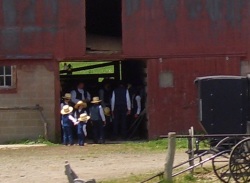Here is Part Four in the series on Amish Religious Traditions from the informative Amish News based in Lancaster County, Pennsylvania. Today the post deals with the traditions of Amish Communion and Foot Washing. Remember, this article deals with the traditions carried on by the Amish in Lancaster County, Pennsylvania area. Other Amish districts may have differing communion traditions.
For those of the Amish faith, communion is an important religious service, held only twice a year --- in the spring and fall. The actual communion service is not necessarily held on a Sunday. As is the Amish custom, religious services are held in the home, not in a church building. The geographic area where the Amish live is divided into church districts for this purpose.
At a church service two weeks prior to communion, there is a "Council Meeting." Only baptized members attend this meeting and the communion service. The rules of the church and other matters are discussed. Scriptural passages from the Old and New Testaments as they relate to the Amish are explained.
On the day of the communion service itself, the congregation again gathers at a member’s home. Commonly, men sit in one room and women in another.
Hymn singing begins the service as the preachers and bishops leave to discuss who sill be giving the sermons. The second hymn sung is always the same (#131), "Das Loblied," or "hymn of praise." The hymns are sung in German, with no organ or musical accompaniment. Singing is in unison with no harmonizing. The singing may go on for more than 30 minutes.
There is a short opening sermon, followed by a longer second sermon, lasting about two hours. During this and continuing into the main sermon, a few people leave off and on to eat. Since this service lasts well past noon, this is the way that everyone eats without taking time for a break.
At some point in the main sermon, which takes about three hours, two deacons leave to get the wine and a large, round loaf of bread. The bread, wrapped in a white cloth, is uncovered and cut before the congregation. While all stand, each member receives a piece of bread, starting with the bishops and preachers, the other men, and finally the women. Upon receiving the bread, each person puts it in his mouth, genuflects, and sits down to eat it. The congregation then rises again to receive the wine. The wine is poured into a cup, and each person takes a swallow, genuflects, and is again seated.
Buckets for the footwashing are now brought in. Shoes and socks are removed. One man stoops over, washes, and dries the feet of the other man sitting in the chair. The two then switch places. The men exchange these words, "The Lord be with us. Amen, in peace." They give each other the "holy kiss" and then return to their seats. This continues until each man has had his feet washed at the chair. Women follow the same procedure in their room. More singing then concludes the service.
Afterwards, as the congregation leaves to go home, the men slip some money into the hands of the deacon. It is only at the two communion services that an "offering" is given. The deacon quickly slips the money into his pocket. This money is used for any emergency or special need that might arise among the members.
Thus, in many ways, the rituals and sharing that comprise the communion service confirm the bonds of faith and community that are so important in Amish society.






















